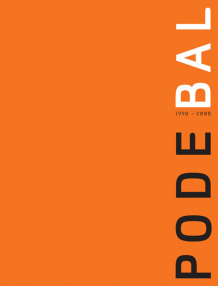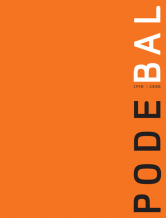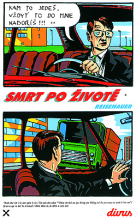| Zeitschrift Umělec 2004/3 >> New Fetishisms | Übersicht aller Ausgaben | ||||||||||||
|
|||||||||||||
New FetishismsZeitschrift Umělec 2004/301.03.2004 Cosmin Costinas | study | en cs |
|||||||||||||
|
A New Generation
in Romanian Contemporary Art The most visible phenomenon on the Romanian contemporary art scene is the occurrence after the year 2000 of a seemingly homogenous young generation, between the ages of twenty and thirty. Indeed, this generation is currently engaged in an active process of defining itself as a group, as a “young generation,” with all associated implications. However, one can observe some fundamental differences among the representatives of this wave. If one were to seek a common feature for this generation, that would definitely be its fetishism towards the forms of different underground movements, and towards various global subcultures. The generation, of over forty participants (the so-called “Soros kids”), can be defined through its obsessive relationship—a real fetishism—with new media, newly discovered and often used as a weapon in their arguments with the old establishment. The new generation has assumed this experience and thus the new media are now taken for granted and used more naturally. The previous generation’s main issues were (and remain) specific to the mainstream of the global art world of the nineties: The problems of local and national identities in the European and global context, matters connected to urbanism and new forms of urban living, new technologies and, of course, the often exaggerated and primitive over conceptualization of new media, for which, after a few necessary and already historical exhibitions at the beginning of the nineties, such as Ex Oriente Lux and 010101. Curated by Subreal group member Calin Dan, a large number of exhibitions were organized with the sole purpose of justifying and explaining them. The theoretical approaches to these issues were of a nature imposed by the realities of the Romanian post-Communist society and the Soros program, but without an explicit leftist content, mainly due to the compromised reputation of socialism after the half-century of its totalitarian version. The new generation exorcised many of these obsessions, mainly the desperate assumption of an Eastern exotic and transitional identity, again an obvious consequence of the Soros program and of the later “European” and “Balkan” Projects. The young generation’s program is obviously one of integration and communication with global art trends, eliminating any reference to local identity. The Romanian young generation wants to be called a young generation without being explicitly Romanian. And, of course, the most comfortable way of acquiring such a status was the often formal and superficial embrace of underground cultures: Club and urban culture, graffiti art, etc. This altermondialist solution became the mark of the young generation of Romanian artists. It is now self-understood that a video artist would often be a club VJ, that an artist working mainly with photography would also perform as a photographer for fashion and lifestyle magazines—often not only out of financial need—and that almost any Romanian artist would be a street graffiti artist, doing “conceptual” stencils, mostly. The search for institutionalized forms of communication, collaboration and exhibiting is another hot issue; any artist, beside his/her personal projects is involved in a search for these institutional formulas, often assuming the role of promoter, cultural manager, curator and PR agent. It is said that when three Romanian artists meet for a beer they don’t discuss about their future art works but rather about creating a new gallery, or at least a mailing list. This is a consequence of the severe lack of professional curators, art managers and theoreticians, the existing ones could all barely form a football team. But of course, the main reason for this is the institutional quasi vacuum of the Romanian art scene after the closing of the Soros pocket, and more profoundly of the personality crisis and the ambiguous profiles of the existing institutions. And if all these features expressed until here rather infirm than confirm my first assertion about the profound differences among the young generation, these differences occur here, in the relationship between the young artists and the art institutions, and more profoundly in their political program which determines these relationships. Romania’s Big Cities Geographically, the Romanian art scene gravitates around three centers: Bucharest, Cluj and Iasi. Other big cities—like Timisoara, which at the beginning of the nineties had one of the most dynamic spaces for contemporary art in Romania (certainly the place to be for an actionist artist), or Brasov, the second Romanian city in economic importance—may only get good grades when it comes to the authenticity of the notion of underground. The young artists in these cities are almost exclusively focused on experimental electronic music, Japanese Manga cartoons or on creating alternative clubs and cafes. The young generation of artists that emerged in these the cities was connected and shaped through the institutional context of each city. It is fair to say from the beginning that this generation appeared after the end of the large financial boom coming from the West in the nineties, so their connection to local institutions and contexts was naturally stronger. In Iasi, this phenomenon was seen around the Periferic Biennial. The contemporary art festival, which was organized by the Vector group, had an interesting and coherent trajectory. Beginning as a local performance festival not unlike others in the 1990s’ Romanian scene (all of which have silently vanished in the mean time), Periferic, grown out of local resources and needs and shaping together with itself the local art context, transformed into an important regional festival of contemporary art. Its profile and aims have always been clear; it is an independent and critical festival, with special attention to the local realities, Iasi being simultaneously one of the traditional cultural centers of Romania, but also one the poorest of the country’s big cities. It is fair to say that this event is held alive by a team of young artists who have grown up with the festival. The whole context of Cluj is quite different from the rest of Romania. Its multicultural aspect, its superior economic situation to the rest of Romania and its privileged links with the Hungarian and Central European space left visible marks on the local art scene. Institutions shaped an interesting, diverse and dynamic art scene. The Cluje version of Balkon magazine, later transformed into IDEA Arts+Society has a very clear political program and is the most important pole of the Romanian leftist intellectual life, stretching beyond the visual arts field. Studio Protokoll is a production and exhibition space with a coherent critical and independent position. There is also Tranzit House, and DMedia group, an association focused on alternative and free media, open source issues and internet policies. This art scene is made up by artists like Ciprian Muresan, Cristi Pogacean and Istvan Laszlo (forming the Supernova group, focused on projects debating economic issues and media clichés) and Duo van der Mixt group (Mihai Pop and Cristian Rusu). In addition, there is the Version magazine project. Created and coordinated by Ciprian Muresan and Paris–based Mircea Cantor and Gabriela Vanga, Version is probably one of the best known (internationally), projects created by Romanian young artists. It is a collaborative platform, an artist run magazine functioning simultaneously as a space to present projects, to debate issues of contemporary art and society and to support projects that use Version as a medium of expression. Version has been included as an art project in various international shows. The Bucharest young art scene is more extended and more diverse with various groups, trends and positions. The representatives of the former Rostopasca group that functioned in the late nineties—now working separately in different media, from net projects to painting (Nicoale Comanescu and Dumitru Gorzo are probably the most preeminent young Romanian painters). The members of the former Cutter group (Cosmin Gradinaru, Ioan Godeanu-living in Germany and Dan Panaitescu), who took their name after a radical act, during their student period, in which paintings of their colleagues were sliced up as a gesture of protest against the privileges of the low quality and old media in the art education system; the Cutters were subsequently kicked out of the Art University but then re-enrolled after official intervention by the very liberal Minister of Education of that time. Another group, blended together under the name of young Romanian photographers (Stefan Cosma, Alexandra Croitoru, Ioana Nemes, Vlad Nanca and Daniel Gontz), represents the most dynamic part of the Bucharest art scene. These artists’ work is mainly focused on urban culture, trends and lifestyles. Although similar in their attitudes with the young movements throughout the western world, being antiwar and critical towards aspects of globalization, their works are neither explicitly political nor totally leftist, when compared to the works of most of the Cluj based artists. Their attitude is understood more as a lifestyle choice than as an actual critical position. Its influence on the very young art students and its media notoriety is considerable. Interestingly, and relevant for the entire Romanian art scene, none of these artists had finished art studies in the Romanian education system, thus demonstrating the total bankruptcy of the art universities. Recently, this very diverse scene underwent an extremely dynamic and, in the context of Romanian post-Communist art, a somewhat surprising process of communication and coagulation. Such is the case with projects like Rebranding Art in Romania, a network of home galleries— exhibitions organized in artists’ apartments and then transported throughout the Bucharest, Cluj and Iasi network. The most dynamic was at Vlad Nanca’s apartment, also known as the 2020 Gallery, a space that was also included in an official program, Vienna Days in Bucharest. But the most important factor of cohesion has been the Incepem mailing list that developed around this network. It must be said that a fundamental role in the self-awareness of the Romanian contemporary art scene had been earlier been played by the Romanian section of the nettime mailing lists, introduced and moderated by the Timisoara based artist Alexandru Patatics. The Incepem list began with very young artists but soon transformed to become a relevant forum for the entire scene. Nevertheless, this new situation of the Romanian young art scene was unable to surpass the different positions and political attitudes, or find a common position assumed by the majority of the young artists. This autumn’s opening of the National Museum of Contemporary Art in Bucharest in the People’s House, Ceausescu’s megalomaniacal palace and the current site of the Parliament, marked an important change in the Romanian art scene. It signified the end of a period where the state support for contemporary art had barely existed, the whole scene being defined as a mere avant-garde experiment and thus an appendix of the national budget concentrated on the old media with their old masters. But because of the strong state control of this institution, an important part of the contemporary art scene protested against the current status of the Museum. This movement clarified positions between the independents, enthusiastically assumed by many artists even before the creation of this Museum, and the politically unengaged. The young generation is somewhat split between the radical positions of those who have chosen not to participate and collaborate with the Museum and those who have. However, the high level of self-awareness of the young generation, and strong personal contacts can encourage the belief that this is a temporary state and that common formulas of expression could be found in the near future.
01.03.2004
Empfohlene Artikel
|
|||||||||||||
|
04.02.2020 10:17
Letošní 50. ročník Art Basel přilákal celkem 93 000 návštěvníků a sběratelů z 80 zemí světa. 290 prémiových galerií představilo umělecká díla od počátku 20. století až po současnost. Hlavní sektor přehlídky, tradičně v prvním patře výstavního prostoru, představil 232 předních galerií z celého světa nabízející umění nejvyšší kvality. Veletrh ukázal vzestupný trend prodeje prostřednictvím galerií jak soukromým sbírkám, tak i institucím. Kromě hlavního veletrhu stály za návštěvu i ty přidružené: Volta, Liste a Photo Basel, k tomu doprovodné programy a výstavy v místních institucích, které kvalitou daleko přesahují hranice města tj. Kunsthalle Basel, Kunstmuseum, Tinguely muzeum nebo Fondation Beyeler.
|





































 New book by I.M.Jirous in English at our online bookshop.
New book by I.M.Jirous in English at our online bookshop.
Kommentar
Der Artikel ist bisher nicht kommentiert wordenNeuen Kommentar einfügen